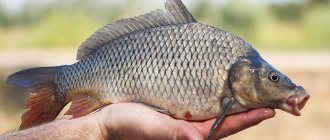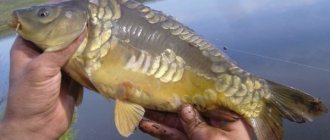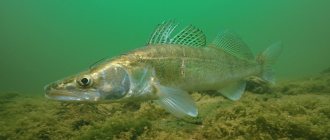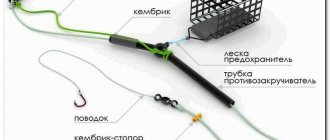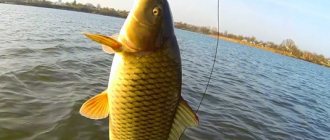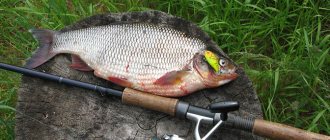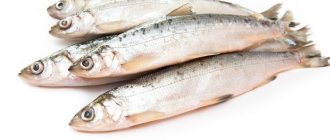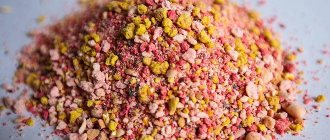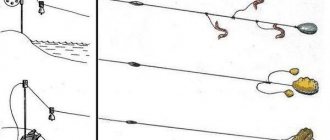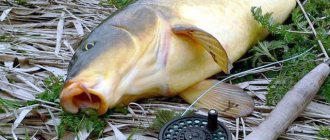- Wild animals
- >>
- Fish
Mirror carp is one of the first successful experiments, as a result of which it was possible to breed fish under artificial conditions to increase the population size, as well as its weight and nutritional value. At the same time, in addition to its industrial importance, the mirror carp has also become the most beautiful representative of the family.
Origin of the species and description
Photo: Mirror carp
Mirror carp belongs to the carp family. Its main difference is that this particular variety was bred artificially. Some call the Mirror Carp a domesticated carp. But it is still different from carp. Mainly with a smaller head and an elongated upward body.
Interesting fact: Mirror carp was bred artificially.
Carp includes many different species. Only the mirror one, which is often called domestic carp, is considered domesticated. In addition, there is the common carp and others, most of which are named based on the name of the area where they are most common.
Video: Mirror carp
Initially, Mirror carp was bred by breeders with the goal of creating a species of fish that would have large mass, dimensions, nutritional value, and at the same time be unpretentious in terms of care. It is the Mirror carp that is a representative of the family that can be fed with grains and other plant crops that are easy to obtain and also have a high value for weight gain by the fish.
The main features of this type include:
- large fish sizes;
- unlike almost all other types of carp, the scales of the Mirror are silvery, very large in size, but there are few of them on the body;
- there are much fewer rays on the fins;
- lives mainly closer to the shore.
- All this is essentially the result of crossings of different subspecies of cyprinids, as well as their adaptation to the necessary living conditions.
Interesting fact: Many breeders call representatives of the species living in natural conditions simply wild individuals.
Work on crossing carp and carp continues. This makes it possible to achieve an even greater increase in the body weight of fish and their growth rate. The mirror carp itself was discovered by German scientists.
Types of carp
In addition to the common taxon, which is distinguished by its hardiness and is a breeding base for fish farms, other cultivated, artificially bred breeds are grown in ponds, rivers, lakes and reservoirs.
Mirror carp
The species became the first successful breeding experiment associated with increasing the fertility and weight of fish. The first examples of the new breed appeared in Germany at the beginning of the 19th century under the sonorous name spiegelkarpfen (mirror carp). The main differences from the original form were more rounded fins, fewer bony rays, a rapid increase in weight and a special arrangement of shiny scales that cover only part of the body and resemble rounded mirrors. There are several basic patterns of protective covers that give names to varieties of mirror carp - framed, scattered, linear. An important biological feature of the species is its feeding affinity for mollusks and cereals, which significantly simplifies keeping the fish in artificial conditions.
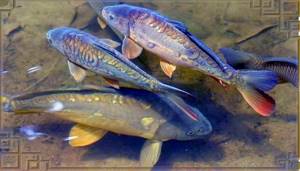
naked carp
The variety arose as a result of further selection of the mirror crown. The main exterior feature is the complete absence of a hard protective cover. Another common name for the taxon is leatherback carp. The breed standard allows for a minimum number of large scales on the back and at the base of the caudal fin.
Due to weak immunity and susceptibility to parasites, the fish is of no economic importance and is mainly bred as a popular object of recreational and sport fishing.
Carp
Fierce food competition between the two species forced fish farmers to look for a compromise solution that would allow them to control the number of super-prolific crucian carp (Carassius) in the reservoir and prevent severe reduction of the stock. In the mid-1980s, a special breed was bred in Russia - carp carp, which was distinguished by its rapid weight gain, high nutritional value and inability to reproduce independently due to the complete sterility of the males. The hybrid has a unique appearance - the head and color of a crucian carp, the body of a carp. Thanks to excellent adaptability, omnivorousness and high biological potential, in just 2-4 years the fish grows to 1.5-2 kg.
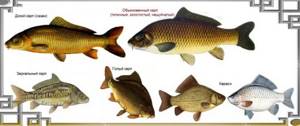
Koi carp
The idea of crossing closely related generic taxa Cyprinus carpio and Carassius is not new and has a strong historical basis. Back in the 1st-2nd centuries, the Chinese managed to obtain offspring from wild carp and local crucian carp (Carassius auratus), which is known to aquarists as goldfish. The resulting hybrid retained the body of the carp and the ability to reproduce, but acquired an unusual red or white body color. Further intraspecific crossing allowed us to obtain pink and spotted forms.
To learn more:
Podust: fish lifestyle and fishing methods
From China, the fish quickly made its way to neighboring Japan, where it became a lifesaver for rice farmers in mountainous areas. Heavy winter snowfalls cut people off from cities for many months, leaving them without supplies of protein food. This is where the unpretentious fish came in handy, as it thrived in special tanks for storing irrigation water.
The Japanese word "koi", translated as "carp", has become the main word for this colorful, long-lived taxon, growing over a meter in length. The Japanese themselves use the term “nishikigoi”, literally - brocade carp, of which more than 80 breeds have been bred, including with the participation of a mirror relative. Now the fish inhabits homestead and park ponds in all corners of the country and is an object of aesthetic and cultural content.
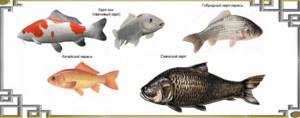
Siamese carp
The most numerous representative of the family Cyprinidae is the genus Catlocarpio, which lives in Indochina in the rivers, lakes and reservoirs of the Gulf of Thailand, Andaman and South China Seas (Mekong, Chao Phraya, Tonle Sap, Saigon, Phumphon). Siamese carp, or giant barbel, leads a peaceful lifestyle, preferring plants, algae, fruits, grains, and phytoplankton. Despite the low-calorie diet, the average size of the fish exceeds 30-40 kg. There are known cases of catching record-breaking individuals weighing up to 300 kg with a body length of more than 3 meters.
Appearance and features
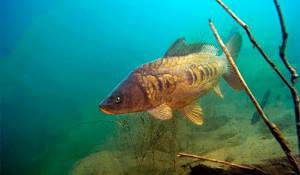
Photo: What does a mirror carp look like?
A distinctive feature of this type of carp is its large size. Mirror carp can reach 1 m in length and weigh up to 15 kg. Mirror carp is a real aesthetic pleasure for the fisherman who catches it, because it is really difficult to take your eyes off the shimmer of its scales. The scales are usually pearlescent with a green, golden or brown tint.
Large scales are located in the middle of the body closer to the tail. But near the pectoral and dorsal fins there are no scales at all. It is interesting that the appearance of an adult mirror carp directly depends on the conditions in which it lives (quality of life, depth, sufficient oxygen). Fish can adapt to different living conditions, changing their appearance to suit them.
Interesting fact: Such large scales are a consequence of the industrial importance of the species, since such fish are simply easier to clean.
Since the Mirror carp was originally bred as an industrially valuable species, the features of its appearance also have a characteristic practical significance:
- minimum scales throughout the body;
- minimal number of rays, reduced fins;
- less developed head;
- prone to obesity, so they often look round and have a more rounded body.
Interesting fact: Naked carp is considered an even rarer variety - absolutely without scales of a diseased shade. It practically does not live in natural conditions.
Many argue that in natural conditions, mirror carp can easily live up to 50 years and, almost constantly increasing, reach impressive sizes by this time.
Description of varieties
As mentioned above, carp are divided into several types depending on their scaly cover.
Scaly carp
The common or scaly species are considered the closest relatives of the carp. If we compare them with other members of the family, they are famous for their rapid growth and weight gain, their ability to adapt to any conditions, and also to live in shallow ponds where there is stagnant water. In addition, carp are often caught in deep cuts and rivers. As for the scales, they are completely light, evenly covering the entire body. If you look at images of fish, this feature will be especially strongly emphasized.
Mirror carp
It is a popular subspecies of carp that has virtually no scaly covering. German scientists worked on breeding such a hybrid and applied a number of gene changes. The result is a distinctive look with the following characteristics:
- The mirror carp has a unique distribution of large scales with a silvery and mirror tint
- The fish has a minimal number of rays on its fins.
- An individual can gain impressive weight much faster than its close relatives.
- The main portion of the diet is occupied by cereals and shellfish. The fish is found in shallow water areas and almost never goes to depth, because it needs access to aerated water.
Also found in nature is another unique species - naked carp. It is also called leathery, which is associated with a distinctive feature in the form of a complete absence of scales on the body. It is also distinguished by its characteristic marsh color or greenish tint. Naked carp are rare inhabitants of water bodies, so catching them is considered a real event for every fisherman.
Karpokaras
It is no secret that in almost every body of water there is a huge population of crucian carp . And in rural regions, this underwater inhabitant is particularly widespread. Due to their high fertility and early maturation, crucian carp quickly reproduce in carp ponds, forcing the latter to feel intense competition. But if the former are distinguished by good resistance to any conditions of detention, including low oxygen levels, then the latter quickly die in such an environment. To create a sterile “sterile” form of this species, ichthyologists had to use the hybridization method.
As a result of crossing a male crucian carp with a female naked carp, scaly and linear subspecies . The linear variety repeats linear carp in almost everything, while carp in the second year of its life already weighs 400-500 grams, and in the third - about 1.5 kilograms. The hybrid is bred mainly for sport and farm fishing, in particular in stagnant reservoirs where there is no possibility of draining water.
If six-year-old female carp produce eggs, then 200-gram crucian carp produce milk using a pituitary injection. In this case, a 2-fold injection dose is used for crucian carp of 1.5−2 mg/kg of individual weight. To fertilize a kilogram of carp caviar, you need about 5-7 ml of crucian carp milk. The fertilization rate is about 100 percent.
Histological studies confirmed the complete sterility of carp carp due to the characteristic features of the reproductive system. It is advisable to breed this variety for sport fishing, which is explained by its attractive presentation, as well as high levels of fish productivity. Hybrids are also famous for their good economic prospects, because they are omnivorous and resistant to unfavorable living conditions. In a short period of time, these hybrid subspecies gain impressive size and weight.
Where do mirror carp live?
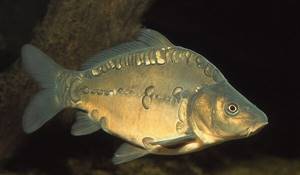
Photo: Mirror carp in the river
Since the mirror carp was bred in artificial conditions, it also mainly lives in private reservoirs. But at the same time, significant efforts have been made to populate natural reservoirs with representatives of this population. To achieve this, numerous efforts have been made to select the most comfortable conditions for the Mirror carp to live.
Basically, all cyprinids live in Europe and Asia. In Russia, they are most common in the Far East, but within the southern latitudes. The basins of the Black, Azov, Baltic and Caspian seas are their main distribution area. It should be borne in mind that cyprinids live exclusively in fresh water bodies.
Mirror carp does not like fast currents. That is why he finds artificial reservoirs with standing water simply ideal for life. Alternatively, in natural conditions it can live in lakes or rivers where the current is very weak. Carps also love clay bottoms. This choice is not accidental. In winter, carp hibernate, choosing the bottom for this and becoming covered with a thick layer of mucus. Carp also hunt closer to the bottom of the reservoir. Their special love for the comfortable conditions of staying at the bottom is connected with this.
Mirror carp are forced to live in shallow water. This is due to the fact that fish simply need oxygen in large quantities. There is no proper concentration in the middle and lower layers of the reservoir. At the same time, they are actively looking for shelter, so reservoirs with the purest water and a flat bottom are not an option for them. Mirror carp will not refuse various snags, holes, ledges and other places where, if necessary, you can safely hide.
Now you know where mirror carp are found. Let's see what this fish eats.
Mirror carp is a domesticated freshwater fish, carp.
For a long time, humans have successfully domesticated not only land mammals, but also a variety of fish for use as food. An example is the freshwater fish mirror carp, which has long been the object of breeding and selection work to obtain new breeds of this fish. It is a domesticated carp and its most common breed. For example, in the 80-90s of the last century, commercial products of this particular carp accounted for 80 percent of the total volume of fish grown in Russian pond farms. Currently, it is grown not only at natural temperatures (in lakes and artificial ponds), but also in various warm-water farms. It was possible to expand its distribution area to the north into Western Siberia thanks to the bred cold-resistant form (Altai mirror carp).
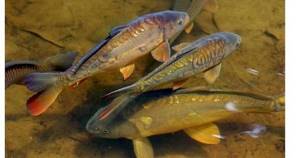
What do mirror carp eat?
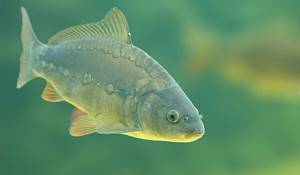
Photo: Mirror carp fish
Legends can be made about the gluttony of representatives of the carp family. Mirror carp is no exception. He eats almost all the time he is awake. At the same time, in order to find food for itself (if we are talking about natural habitat conditions), it can move for quite a long time and quickly.
Although carp are often classified as bottom fish because they prefer to live and hunt closer to the bottom, in fact they can readily search for food in all layers of water. Although carps prefer mainly animal food, they are not averse to eating duckweed for lack of anything better. At the surface of the water they can collect fallen insects (dragonflies, butterflies, midges). But closer to the bottom, the Mirror carp begins to look for mollusks and crustaceans.
In the water column, he perfectly finds fry and eggs of other fish, which he can also feast on. Among plant foods, young reeds find the most attractive. In addition, carp can constantly filter water by drawing it in through their gills. This allows it to receive the smallest particles of food dissolved in the water column. Thus, the carp is never left without nutrients.
Cyprinids usually recognize suitable food for themselves using sight and smell. It is the capture of odors that allows them to smell prey even at a great distance.
Interesting fact: There is a completely logical explanation for such a significant gluttony of cyprinids - they do not have a stomach, so there is nowhere for food to linger. That is, few nutrients have time to be absorbed from the food consumed.
In the winter season, as well as during the spawning period, carp practically lose interest in food. By the way, fishermen need to take this into account, because then any bait will be powerless. After spawning, cyprinids begin to actively gain weight again and replenish losses. But in the summer, they prefer plant foods, even occasionally not disdaining fruits and berries. In the autumn, in order to accumulate enough protein before wintering, carp again switch to an animal diet.
Interesting fact: Under artificial conditions, it feeds on cereals without any problems.
Carp, carp and crucian carp
Carp, carp and crucian carp are species of fish of the carp family, order Cyprinidae. They differ in body structure, lifestyle and habits. However, all cyprinids have the same structure of internal organs. The fish has a lower mouth, so it is characterized by a bottom feeding method. There are 2 varieties of carp: river and pond. River carp is called carp (the ancestor of all species and breeds), and pond carp is a cultivated river fish. One of the main features of all carp is 2 antennae near the upper lip. The differences between the given forms of fish are that pond carp are taller and thicker. However, river species are characterized by rapid growth and great cunning.
To better understand what the difference is between carp and carp, just look at the body shape: river fish have a more elongated and streamlined body, while pond fish are round, have darker scales, and also have a hump between the back and head. In recent years, there has been a decline in the number of carp, and it is rare to find it in a fisherman’s catch. Basically, carp weighs about 5-6 kg, life expectancy is 30-35 years.
There is also a great similarity between carp and crucian carp, but crucian carp has the following distinctive features:
- lack of mustache;
- the body is strongly compressed laterally, high and elastic;
- lighter, smaller and tougher scales;
- smooth outline of the dorsal fin.
It is worth noting that there is crucian carp that lives in the sea. However, it belongs to the order Perciformes, not Cyprinidae. Basically, domesticated carp are distinguished by how the fish looks, i.e. by color and number of scales:
Each variety of carp has its own characteristic body structure. There are subspecies that resemble the body shape of silver crucian carp, and there are, on the contrary, with an elongated body.
Features of character and lifestyle
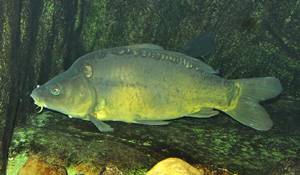
Photo: Mirror carp in a pond
Carps are fish that prefer large groups. They rarely live alone. Only very large adult individuals can afford this. However, they still prefer not to stay too far from their relatives. In winter, cyprinids try to unite in the largest schools possible - this way it is easier for them to wait out the frosts. To do this, they choose deep holes and there, half asleep, they wait for spring. If such a hole could not be found, then the cyprinids settle under the snags.
Mirror carp go to winter when the water temperature begins to drop sharply. Then the carp lies on the bottom, slows down its breathing and gradually refuses food. In this way he manages to survive the severe frosts. In order not to freeze, carp are covered with a thick layer of mucus mixed with fat. But in the spring, when the water warms up and the ice finally melts, the carp will wake up.
Young individuals prefer reed thickets closer to the shore, but mature relatives may well live closer to the bottom. In summer, they can travel deeper distances in search of food. Cyprinids are sedentary fish. They try to almost never leave their favorite habitats. Even if they have to move, they try to do it at minimum distances. If you need to swim somewhere, then carp move in small schools and swim in a line.
They choose dark places to live; they avoid places that are too bright and easily visible. Carp can often jump out of the water - this is a sign that they are going to get food for themselves. But if this happens too often and the carp jump high, then this indicates an imminent change in the weather for the worse.
Interesting fact: Carp has excellent vision, distinguishes colors and can view the world around them at 360 degrees.
Lifestyle Features
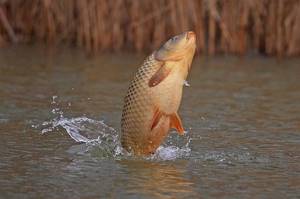
After birth, carp fry gather in numerous schools, but as they grow older, these schools break up into smaller ones, which is associated with changes in the fish’s diet. Eventually, trophy individuals begin to lead a separate way of life. The highest degree of carp activity occurs during the warm period, from April to October.
The first peak of active feeding of carp occurs in June, when the fish, hungry after spawning, begin feeding around the clock. With the arrival of the summer heat, it is better to catch carp early in the morning or late in the evening. If the weather is rainy and cloudy outside, the carp feeds throughout the day, both day and night.
The second peak of active feeding begins in August and continues until the end of October. This is due to the arrival of cold weather and the carp begins to actively stock up on nutrients for the winter. During this period, he actively hunts and takes any bait. Therefore, at this time, carp often becomes part of the catch of amateur fishermen. Carp overwinter in wintering pits, where there is a weak current, together with other representatives of their family. During this period, the carp practically does not feed until spring, being in a state of suspended animation.
Social structure and reproduction
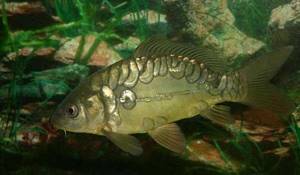
Photo: Large mirror carp
To some extent, mirror carp can be called a schooling fish, but only partially. This is due to the fact that mirror carp live in schools only for a certain time. When they turn 5-6 years old and become fully sexually mature, they disperse throughout the reservoir and then continue to live independently, coming together in groups only during the spawning period.
Mirror carp can begin to spawn only if the water in the reservoir has warmed up sufficiently. This usually requires a temperature of at least 16 degrees. Spawning occurs in the spring. It is precisely because of spawning that representatives of this species spend March and April very actively, frolicking in the water in every possible way.
The eggs ripen 4 days after they are laid. Mature individuals can spawn. They reach this age at about 4-5 years. To spawn, a sexually mature female of 3-5 years old needs to look for several males at once, and then go with them to shallow water (depth no more than half a meter). The bottom in this place should be overgrown with soft algae.
Then, over the course of 2-3 days, the female lays eggs in small portions. On average, one female can lay out from 100 thousand to 1 million eggs. When the larvae emerge from the eggs after 5 days, they will continue to develop in a static position for about a week. At this time, their only source of nutrients is the yolk sac. Further, when the fry begins to swim independently, it will begin to feed on small crustaceans on its own.
It should be noted that all representatives of the carp family are not so highly organized, therefore, nature does not provide any care for their offspring. After the female has laid her eggs, she and her partners move away without guarding the area. In artificial conditions they are also isolated from their offspring.
Oven recipes
The most popular dish is mirror carp baked in the oven. You can prepare it in several ways, here are some of them:
1. A small fish needs to be cleaned and gutted, rubbed with a mixture of ground black pepper and salt. Then make several small shallow cuts on the sides of the carcass and insert lemon slices into them. After this, pour plenty of lemon juice over the fish and put it in the refrigerator for an hour and a half.
While the carp is marinating in the refrigerator, you need to prepare the filling: finely chop the cabbage (for cooking you can use either sauerkraut or fresh), add salt and pepper, then fry in a frying pan without a lid with olive oil. Separately, cut the onion into half rings, mix mayonnaise and sour cream (50 grams each).
After this, you can start stuffing and cooking the mirror carp in the oven. According to the recipe, you need to spread the onions on foil and put the fish stuffed with fried cabbage on top. Then wrap and place in an oven preheated to 220 degrees for 15 minutes. After the specified time has elapsed, unfold the foil, coat the fish with the previously prepared sauce, and after 20 minutes add the sauce again. After re-coating with mayonnaise and sour cream, the carp should simmer in the oven for another 15 minutes until completely cooked. The finished dish is served with vegetables and lemon. Bon appetit!
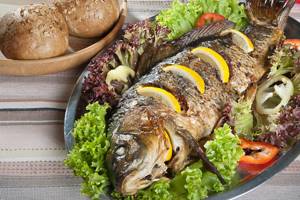
2. Stuffed carp. Ingredients: fish fillet, onion, milk, bun, salt, pepper. First you need to grind the carp through a meat grinder, as well as pre-chopped and fried onions in vegetable oil. Add a bun soaked in a small amount of milk to the resulting minced meat, mix thoroughly, add spices to taste. To obtain the desired dense consistency, beat the fish mixture with your hands for 15 minutes, then form small sausages and wrap each one in foil. Bake in the oven at 160 degrees for 30-40 minutes. After the time has passed, let the dish cool, separate the sausages from the foil and cut into pieces. The finished fish dish can be decorated with herbs and served with boiled potatoes. A prepared salad of fresh tomatoes and cucumbers would also be an excellent addition. Bon appetit!
Natural enemies of mirror carp
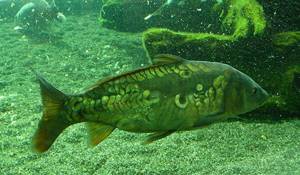
Photo: What does a mirror carp look like?
If we talk about representatives of the population living in artificial conditions, then their percentage of enemies is much lower. Different fish are not placed together, but carp never show hostility among themselves, so they cannot cause any harm. In natural conditions, everything is much more complicated. Although carp, like many other fish, the main threat is from humans. Especially when it comes to such an industrially valuable species.
In addition, there are plenty of enemies among representatives of the natural environment. This is why carp tries to be careful, despite its impressive dimensions. Frogs always pose the greatest danger - they love to eat eggs and even fry. Thus, in one day, 1 frog is capable of destroying almost the entire clutch of one female. Crustaceans and other fish also do not refuse such a delicacy.
If the eggs are brought too close to the shore, then birds, animals can eat them there, or they simply dry out. Large pike, catfish and even other larger carp may well eat small adults. Seagulls and other birds of this kind pose a particular danger to young cyprinids - they very often hunt them and can destroy them in large quantities. It is extremely difficult for carp to fight these enemies, which is why they often prefer to choose more secluded habitats.
Habits and food supply
Mirror carp are considered a schooling fish. Up to a certain age and size, they prefer to live in groups of 5-10 individuals. However, large specimens over 5 kg often try to live in solitude. They gain weight quickly. Already a one-year-old carp weighs about 1 kg. After three years, the fry of this fish reaches a weight of 3 kg and a body length of 50-60 cm.
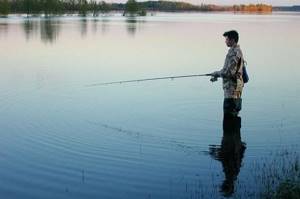
Late spring is the optimal time for fishing for mirror carp
Mirror carp spend the cold season in a sleeping or half-asleep state at depth. His awakening begins in March-April. Spawning occurs in May-June, when the water temperature reaches 15-18 °C. By the way, this fish reaches sexual maturity only at 3-5 years of life.
Fishing for mirror carp begins in May. At this time, in almost all reservoirs the water warms up to 10 °C. The last fishing season is in October-November.
Mainly mirror carp feed on bottom vegetation, young shoots of reeds, eggs of frogs and fish, insects, mollusks and other organisms. If the reservoir is used for breeding fish and organizing fishing, then the food base is compound feed, cereals, grain waste, cake, etc. However, despite the large list of what carp absorb as food, it can be extremely difficult to choose what to fish with.
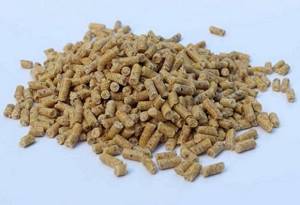
Compound feed is used to feed mirror carp
It is almost impossible to guess what baits mirror carp will like today. His diet may differ significantly from yesterday's taste preferences. Therefore, experienced carp fishermen use a wide variety of baits (including quite exotic ones - cucumber, cheese, berries, etc.):
- worm;
- maggot;
- bloodworm;
- corn;
- pellets;
- boilies;
- dough;
- potato;
- peas and more etc.
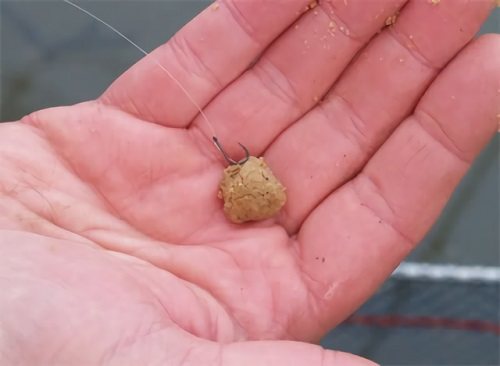
Mirror carp can bite on dough or bread
Features of carp-like
Cyprinids live in fresh water bodies (ponds, rivers), as well as where the water salinity is no more than 10%. Sea carp live in river deltas near the sea, marine freshwater or brackish lagoons.
The diet of carp-like fish changes with the changing seasons. In spring they feed mainly on plants and fish and frog eggs. In summer, most of the menu consists of aquatic insects, worms, snails and other plankton. In autumn, the diet is entirely of animal origin: small insects and invertebrates. During the winter, fish hibernate. They settle in holes and become covered with mucus. Breathing slows down, the fish do not feed on anything.
In the spring, when the spring flood occurs, cyprinids leave their holes and move towards the spawning grounds. They spawn in stagnant water when it warms up to a temperature above 17 °C. Females lay eggs in large numbers. After the males fertilize the eggs, the eggs mature in 3-4 days. There is a version that cyprinids got their name because of their high fertility from the Greek word, which means “fruit”.
Carp is a domesticated carp
In terms of size and popularity, carp occupies the leading place among representatives of its family. It makes up almost 50% of all farmed fish. Since the times of Kievan Rus, the breeding of cyprinids has been widespread. Manufacturers were brought in boxes. This is where the name “box-fish” came from, from which, according to one version, the modern name was then formed.
By the first year, domesticated carp reaches a body weight of 400-800 g, and in the second year - more than 1 kg. Fish can live a very long time - up to 50 years. Such centenarians weigh over 40 kg. A fish with a length of 1 m can weigh up to 12 kg.
Representatives of cyprinids can be found not only in reservoirs of all continents, but also in aquariums, for example, goldfish, zebrafish, barbs, and labeo.
Carp fish adapt well to any freshwater body of water. Having high adaptability and survival, they quickly begin to dominate. Crucian carp is especially tenacious. Therefore, cyprinids are included in the list of 100 dangerous invasive species. In addition, some species of fish of this family pose a danger to humans: they carry the larvae of opisthorchis, a dangerous parasite.
Description
Carp Carp is a cultivated form of carp.
There are several forms of carp: naked, mirror and scaly. Fishermen usually come across wild carp, which somehow got into the reservoir from fish farms. Spawning coincides with the end of flowering of gardens and the opening of the swimming season and occurs in shallow grassy areas. Carp feeds on various aquatic organisms and larvae, as well as all kinds of plant foods. Begins to feed from the time of cherry blossoms. However, in a number of reservoirs, its fishing begins only after spawning. There are reservoirs rich in food, where he generally does not pay attention to the most seemingly tasty baits. In spring and early summer, carp prefer a worm or half a crawler. After spawning, it bites better on cereal grains, potatoes and dough. Real river carp, or carp, is very beautiful. It is covered with unusually large dark yellow-golden scales, which are darker on the back, with a bluish tint, and lighter on the belly; It seems as if the golden field is strewn with carnations with dark caps. At first glance, carp, especially young ones, have a fairly strong resemblance to crucian carp, but it is not so high in the back (the height of the body is only twice as thick), thicker and longer, and immediately differs from the latter with its 4 thick and short antennae on yellow, unusually fleshy lips, almost as mobile as those of bream; These antennae sit in pairs on each side and end in roundish, flat heads. The dorsal fin is very wide, wider than that of other cyprinids, and occupies almost the entire back half of the back, dark gray in color. In addition to its width, it is distinguished by a very strong sawtooth, jagged front ray. The dorsal fin of the barbel myron has such a ray, but in carp the anterior ray of the anal fin has the same structure. All lower fins are grayish-violet, the caudal fins are red-brown; golden eyes. The pharyngeal teeth, lying in the pharynx, found in all carp fish and used for grinding solid food, are distinguished by their massiveness; There are five of them on each side, arranged in two rows. Young carp, 2-3 years of age, are much flatter, wider, humpbacked and lighter than adults, which is why they are sometimes called lapys and croakers. Large carps have an almost cylindrical body.
But both in color and body composition, carp, this widely distributed and even, one might say, domesticated fish, is subject to numerous and strong modifications. On the one hand, there are varieties with a very elongated, almost cylindrical body, on the other hand, there are carp whose body shape is similar to silver crucian carp. The latter seem to be increasingly found in ponds and generally in small enclosed pools, while oblong carp are more often found in estuaries, in the sea or in large lakes.
Carp fishing
Carp are caught with a float rod. The rod must be powerful, even if it is equipped with a reel. The line is usually 0.5 mm with a leader of 0.4 mm. It is clear that the thickness of the fishing line depends on the size of the carp found in the reservoir. For catching carp weighing 1.5–2 kg, a leash thickness of 0.3 mm is sufficient, but for giants weighing 10 kg, a fishing line 0.7 mm thick may be weak, especially for blind tackle. When catching large carp, you need a thick leash (vein leash is unsuitable due to its rigidity) made of silk or nylon, preferably wicker. Camouflage of gear for carp fishing is absolutely necessary, just like camouflage of the fisherman. Sometimes long-distance casting of bait with a sliding float or using a spinning reel helps. Coastal thickets or wicker camouflage shields, which can also be installed on a boat, camouflage the fisherman well.
Reel tackle is very helpful both in long-distance casting and when retrieving, and allows you to use much thinner, invisible line. The sizes of hooks are selected according to the bait, but double-strength hooks are required. By the way, carp have a rather big mouth. You can use hooks ranging from No. 6 to 12, depending on the size of the fish. Carp fishing almost always occurs in algae thickets and from the bottom, so the line and leash are painted gray-green to resemble algae. For successful fishing, it is very important to choose the right fishing location.
At dawn, the carp noisily throws itself up out of the water and with a splash falls back flat. In lakes and reservoirs, it sticks to the deepest places, not far from shores overgrown with algae; it is especially attracted to islands with a wide strip of algae, where the fish go to feed. In rivers, carp stick to quiet, deep holes in slow currents, especially if the banks of the holes are steep and washed away. They often occupy deep bays and oxbow lakes. They are caught not in the pit itself where they live, but on the paths along which carp move to feed. If it was possible to determine their parking place based on the skids, then you need to try to determine which way they will go to the algae thickets to feed. You need a flat area, clear of snags and rubbish, at least 5–6 m long and at least 4–5 m wide, with a depth of no more than 3 m, at a distance of up to 20 m from the parking lot.
On the shore, near the fishing site, sizha is prepared, which is camouflaged if possible. To regularly fish such places, you need to select three or four. Carp feed along and near the shore, not missing the shallows near the riverbed along the way. The bait must lie on the bottom, and the sinker must barely touch it or be 1–2 cm from the bottom. It is very important. It will be easier to notice the fish touching the bait and prepare for hooking in a timely manner. The carp bite is sometimes so fast that the rod ends up jerking into the water. But more often, in the hot season of summer, he carefully takes bait, especially vegetable baits, slightly moving the float, slightly lifting it. Then, if the fish liked the bait, the float, slowly sinking, will go under water. This cutting moment should not be missed. When fishing with grain baits, you need to hook when the float is rising, but if you hook too early, the carp can easily break loose and lead the whole flock away from you. Determining and describing the moment of timely hooking for each bait is difficult, sometimes impossible. This comes with practice.
Masking should be maximum. The fisherman's suit, especially above the waist, should blend into the background of the shore. Walking along the shore is completely unacceptable. The ends of the rods should not protrude beyond the shore line more than 1 m. Even on permanent and already proven feeding routes, carp must be fed. This keeps the flock in the right place, sometimes for the entire dawn, since the flock, slightly frightened by the landing of one, returns to feeding again. Complementary food, like bait, should contain steamed cake. Cereals and potatoes must be cooked with cake.
Fishing for carp After spawning, in mid-summer, carp feed from dusk until dawn, sometimes until 8–9 o’clock. In shaded areas, the bite occurs until almost noon. At the beginning and end of summer, on cool days, carp take better in the morning after heating, when the dew begins to dry. You should not check and re-throw the tackle often and unnecessarily - this scares away the fish. The carp hook should be sharp, but short, especially if the cast was not long. You just need to pierce the fleshy mouth of the fish. Fighting carp requires resourcefulness and endurance. The main condition for success is to counter all the jerks of the fish with a well-tensioned line and pull the fish onto the landing net at the slightest opportunity. When the line weakens, the carp can wrap it around itself and tear it with the sharp teeth of the first ray of the dorsal fin.
In recent years, in reservoirs such as lakes and reservoirs, bottom fishing rods have begun to be successfully used for carp fishing. This fishing has a number of features: long casts are not needed, 8–12 m is enough, it is better if the angler is located 5–7 m behind the coastline, which camouflages him. A carp fishing rod should be at least 1.2 m long; spinning one-handed rods are good. The rod is supported by a powerful fork to counteract the sudden jerk of the fish; signaling devices should be light in weight and as sensitive as possible. Semaphore type signaling devices are especially good. Carp acutely senses weather changes, sometimes stops feeding 2 days before the onset of such a change. The bite also weakens in variable, unstable weather. However, the carp's jumps always show that it is getting ready to feed, but sometimes it bites even without playing. At a feeding site, carp can be identified by bubbles rising from the bottom to the surface as they rummage through the mud, looking for food.
Catching carp requires a lot of patience and composure. Those who are not sufficiently endowed with them are better off catching other fish. But catching large fish often brings unforgettable moments to a skillful and patient fisherman. To catch especially large carp, the fishing rod is specially equipped with: a leash made of nylon or silk cord with a diameter of 0.8 and a length of 8 cm; steel leash with a diameter of 0.3 mm, a length of 30 cm from three elbows; a core of line with a diameter of 0.7 mm and, finally, a reel capable of holding at least 60 m of this line. A steel leash after a soft one is necessary so that the carp does not break the line with the teeth of its fin. Only an end sinker is placed on the bottom fishing rod; sliding ones are unsuitable - they do not transmit the bite well when immersed in silt.
In autumn, with the coloring of the leaves and the beginning of the mass digging of potatoes, carp feed in the afternoon and evening. In cloudy but warm weather - all day, but better in the morning and evening. With the beginning of cold mornings, the carp goes to the most remote and deep holes and stops feeding. The exception is stray carp, which have just been lost from fish farms during the release and fishing of ponds. Once in a new body of water, stray carp look for a place to winter and continue to feed almost until freeze-up, which depends on the availability of nearby places suitable for wintering. In winter, from under the ice, in deep holes and near reservoir dams, large carp are occasionally caught using a brass spoon while trolling perch. In general, they lie down for the winter and become numb when ice appears.
Varieties of carp
There are natural subspecies of common carp, and several cultural forms of fish have been selectively bred. These include, for example,
- mirror, or king carp - a fish with a very small number of scales,
- leathery carp with a completely scaleless body,
- Koi carp are fish with unusually bright, golden or scarlet, solid or patterned coloring.
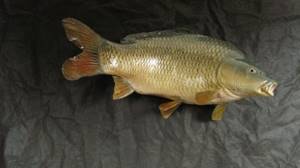
Habitats and diet of mirror carp
In fish nurseries, where selected large individuals of carp-like species are raised, fish breeding scientists for recreational fishing and the national economy have bred a wonderful artificially domesticated breed of fish - the mirror carp, where it has taken root perfectly.
And thanks to breeding work, it took a leading position, acquiring an invasive type of distribution and improving its biological quality indicators of the newly created breeds:
- increased growth and acquired maximum size,
- changed the diet and allowed to accelerate weight gain,
- gained the ability to accelerate sexual maturity and increased fertility,
- significantly reducing the scaly cover and gaining excellent winter hardiness,
becoming an excellent source of human nutrition.
All these fundamental changes were received positively, since consumers of carp fish stocks with a minimum amount of scales found it much easier to clean and much easier to cook.
The distribution area of the mirror species of carp in our country is very wide and includes the European part of Russia and Kamchatka, the south of our country and the Azov-Caspian region, the Western and Central regions of Siberia and the republics of the North Caucasus, the Far East and the Baltic, inhabiting quiet, slow-flowing waters with moderately soft sandy-clayey bottom, slightly silted.
In addition, each region of our country has its own breed of mirror carp:
- in Siberia and Kamchatka, the Sarboyan and Altai cold-resistant species have become widespread,
- in the center and in the north the Central Russian and Ropshinsky, Parsky and Chuvash species are common,
- in the south and North Caucasus - Stavropol and Krasnodar species.
With the increase in the number of mirror carp, its young began to populate nearby habitats - river ponds and natural lakes with warm clear water, where the young fish quickly began to grow and gain weight, and with the change of season, they changed their diet.
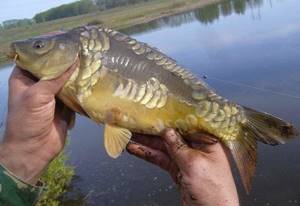
Thus, in the spring of the year, starved mirror carp increases its biological activity, preferring to feed on aquatic vegetation around the clock - young shoots of pondweed and cattails, reeds and egg capsules, happily eating water frogs and eggs of spawned fish.
In the summer, with the onset of heat, the fish’s active feeding stops, and it occasionally looks for food closer to night, more often in cloudy and rainy weather, where its menu includes:
- fat worms and slow snails,
- aquatic plankton and annoying insects,
- molting crayfish and slippery leeches.
In the autumn period, fish feeding becomes more active again, where the search for food becomes the main activity, as mirror carps switch to increased nutrition to accumulate energy reserves, consuming food of animal origin in the form of invertebrate mollusks, arthropod crustaceans and semi-aquatic insects.
With the approach of the cold season and a sharp decrease in water temperature, the fish descend into deep wintering pits, where they become covered with silt mucus and hibernate, being in a half-asleep anabiosis state, slowing down their breathing and stopping completely feeding.
And only with the onset of spring floods with warm days and water heating up to +180C do sexually mature individuals of carp 3-5 years old leave their wintering grounds and head in friendly groups to the floodplain shallow spawning grounds, where closer to night violent splashes and loud noises are heard in the stagnant water.
It is the females who lay eggs on aquatic filamentous algae and hard plants, and the males fertilize them. And now, after 3-5 days, larvae and embryos of mirror carp emerge from the ripened eggs. A little more and the newborn carp fry will swim in search of food - small zooplankton and the smallest crustaceans.
Due to their high fertility and excellent survival rate, good adaptability and increased adaptation, carp fish begin to dominate sharply, threatening biological diversity with their spread, which is why they occupy a leading position in the popularity of recreational fishing in fishermen’s catches.
Of course, the appearance of mirror carp is influenced by living conditions and adaptability to the environment:
- water temperature and depth of the reservoir,
- quantity and quality of food,
- siltation of the bottom and density of aquatic vegetation,
- current speed and the presence of favorite wintering places,
since these species at a young age adhere to a gregarious lifestyle, as they are not aggressive and very sociable.
Thus, carp of different ages coexist peacefully in one school of fish. The largest and oldest individuals of mirror carp prefer to separate from the main school and settle separately at a sufficient depth near steep banks.
In numerous ponds and artificial lakes of fish farms in our country, with the arrival of late autumn, before the first freeze-up, fish farmers catch with nets and nets all the large commercial fish of mirror carp with a unique appearance and sell it to the local population and the trading network.
After a cold winter, they drain all the water and clear the pond of sunken snags and rhizomes of hard reeds, wash it with clean water and fill it again with warm water, allowing it to warm up from the warm rays of the spring sun, after which the next batch of young animals is released.
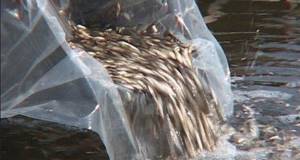
From the very first day, they try to feed young carp to their fullest with special protein-vitamin compositions of raw materials for animal feeding:
- combined feed and grain waste,
- sunflower cake and a mixture of grains and cereals,
so that they grow faster and get fat faster.
For feeding carp, special places are allocated at a shallow depth of the pond, the so-called feeding tables, where fish farmers place combined food and many different foods from cereals and vegetables every morning. The feeding time of the fish is strictly according to the schedule every day, so the carp gets used to this time and swims up to the feeding place in advance.
In the spring-summer period, in the warm water of the pond, mirror carp grow so quickly that the amount of artificial feeding has to be increased, and when they no longer have enough of it, fish farmers set up live food factories with natural food for the aquatic inhabitants.
On the banks of fish ponds and lakes, small ditches are dug, filled with water, where fragrant hay and fresh manure are placed. After a few sunny days, a countless number of daphnia and cyclops are born in them. Along the waterways of the grooves, these microscopic crustaceans swim into the pond, where lake carp feed on them.
By autumn, any of the carp weighs at least 900 grams. Sometimes ugly scars can be seen on the bare skin of the carp - these are cruel traces of an attack on them by a water shrew.
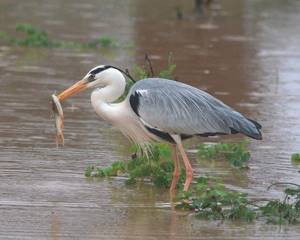
- gray heron,
- water otter
- and a predatory mink
I wouldn’t mind eating fatty carp either. Even such an elegant bird as a kingfisher will definitely make a nest in the nearby reeds in order to catch small carp. Therefore, in ponds it is necessary to protect fish day and night, scaring away fish-eating birds with loud shots and setting cunning traps for predatory animals.
By the end of autumn, the mirror carp finally grows and no longer gains weight. It's time to catch fish.
The water in the pond is gradually drained and after some time, the fish that have accumulated near the dam are collected in huge tanks with clean water, in which the grown fish are quickly delivered to specialized stores, where they are placed in huge glass aquariums with warm running water.
I have repeatedly had the opportunity to observe how mirror carp are caught and sold from such a large aquarium.
